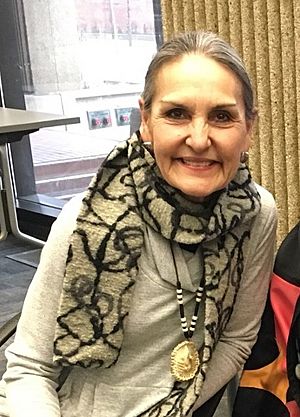Louise Profeit-LeBlanc facts for kids
Quick facts for kids
Louise Profeit-LeBlanc
|
|
|---|---|

Louise Profeit-LeBlanc (2019)
|
|
| Born | November 16, 1951 Whitehorse, Yukon, Canada
|
| Occupation | Canada Council for the Arts |
| Organization | Yukon International Storytelling Festival Society of Yukon Artists of Native Ancestry |
| Known for | Storyteller, keeper of the stories, cultural educator, artist, writer |
| Spouse(s) | Robert LeBlanc |
| Children | Ellenise, Krystal, Tanana |
Louise Profeit-LeBlanc is a talented storyteller, artist, writer, and educator from the Northern Tutchone Nation in the Yukon area of Canada. She grew up in a place called Mayo. Her people speak an Athabaskan language.
Contents
Early Life and Learning
Louise Profeit-LeBlanc grew up in the First Nation of Na-Cho Nyäk Dun in the Yukon Territory of Canada. This First Nation is also known as the "First Nation of the Big River People." She learned the traditional ways of her community. She also spoke the Northern Tutchone language, which is an Athabaskan language. Many people in her First Nation still live off the land. They also have jobs in their communities.
School Days
When Louise was young, she went to a boarding school. However, her grandmother took her out of the school. Her grandmother felt the teachers were not focusing enough on learning.
Later, as a teenager, Louise attended the Yukon Hall residential school in Whitehorse, Yukon. Many Indigenous children in Canada were sent to residential schools. About 150,000 children were taken from their families. They were placed in these schools across the country. Some children were sent far away. Others went to schools close to their homes.
Louise's Career and Work
Becoming a Storyteller
Louise Profeit-LeBlanc learned how to tell stories from her aunt, Angela Sidney. Angela Sidney spent her life making sure the stories of the Tagish people were remembered. Louise grew up listening to her Kookum (grandmother) tell stories. She became very good at it.
Louise learned that a storyteller needs to think about their audience. They should also say a prayer before telling a story. She became a "keeper of stories" for the Nacho Nyak Dun First Nation. This means she helps to keep their old stories safe.
Louise comes from a long line of storytellers. For 15 years, she worked with her people across the Yukon. She helped record and write down the oral histories and stories of the First Nations. This was done so future generations could learn from them. Louise also helped start the Yukon International Storytelling Festival. She also co-founded the Society of Yukon Artists of Native Ancestry. She works to make sure the voices of her people are heard. She believes this knowledge is a gift to share with the world.
Types of Aboriginal Stories
Louise Profeit-LeBlanc explained that there are four main types of Aboriginal stories in the Yukon:
- Classic stories: These are creation stories. They tell how the world was made. For example, how the crow created the universe.
- Regional stories: These are like folk tales from other cultures. They explain things about the Yukon environment. They also talk about how people connect with certain places.
- Familial stories: These stories belong to specific families. They are passed down through generations.
- Communal stories: These are accounts of events that happened in the local community. They usually involve people who are related.
Yukon International Storytelling Festival
In the 1980s, Louise Profeit-LeBlanc and Anne Taylor started the Yukon International Storytelling Festival. It was held every summer in Whitehorse, usually outdoors. Louise's aunt, Angela Sidney, was a famous Tagish storyteller. She had to travel far to share her people's stories. Louise and Anne wanted to create a place closer to home for sharing Yukon stories.
In 1987, people came together to plan the first festival. It took place in 1988. The festival grew over time. It started to attract storytellers from all over the world. It especially focused on stories from Indigenous peoples and countries around the North Pole.
Society of Yukon Artists of Native Ancestry
Louise Profeit-LeBlanc also helped start the Society of Yukon Artists of Native Ancestry. This group supports artists who have Indigenous heritage in the Yukon.
Working with the Canada Council for the Arts
Louise Profeit-LeBlanc worked as the Coordinator of the Aboriginal Arts Office. This was at the Canada Council for the Arts in Ottawa, Ontario. In this role, she helped many Indigenous artists from Canada and other countries. The Canada Council for the Arts helped artists like Rebecca Belmore show her work at the Venice Biennale. They also helped the hip-hop electronica band A Tribe Called Red perform at the WOMEX World Music Expo in Greece in 2012. They also helped them perform at the Association of Performing Arts Presenters in New York City in 2013.
Personal Life
Louise Profeit-LeBlanc was a member of the National Spiritual Assembly of the Bahá'ís of Canada.

